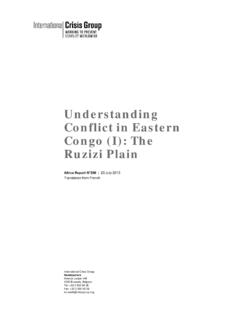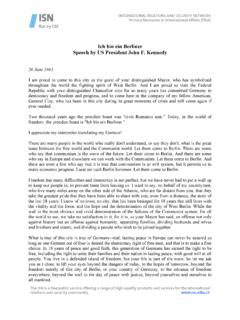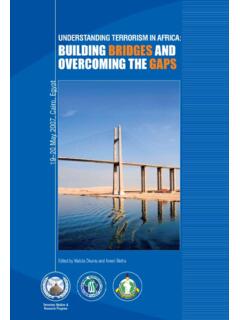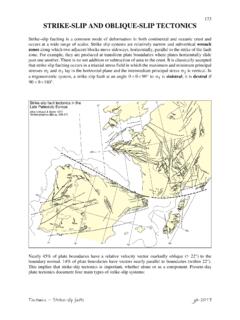Transcription of The Philippines Internal and External Security Challenges
1 SPECIAL REPORTF ebruary 2012 Issue 45 The Philippines Internal and External Security challengesby Zachary AbuzaTen years ago, the Moro insurgency in the southern Philippines was thrust into the international spotlight with evidence that major al-Qaeda attacks were being planned in Mindanao and the terrorist group, Jemaah Islamiyah (JI), was using the region as a training base for operations in Indonesia. Today, the Philippines confronts a Security environment that is more complex and less amenable to simple solutions. Indeed, few countries in the region face as many Internal and External Security Challenges . In addition to the ongoing presence of terrorist groups in Mindanao, the Philippines is beset by several different insurgencies, with significant regions of ungoverned or poorly governed space, endemic corruption, a rapidly growing population, and threats to its maritime resources and continental shelf posed by China s activities in the South China Sea. For Manila these problems are compounded by the limited resources available for national Security spending.
2 The Philippines is a large and important country in southeast asia , and potentially a more active Security partner for Australia. If the Philippines can resolve these various Security problems it will strengthen Manila s place in the emerging asia Pacific order. This paper outlines the range of Internal and External Challenges facing the Philippines and some of the implications for Australia and the region. Political and economic contextPresident Benigno Aquino was elected in May 2010, on an anti-poverty and clean government platform, following the nine-year rule of Gloria Macapagal Arroyo who left office with abysmal public approval ratings, in large part over allegations of corruption and growing inequality. Although Aquino won by a large margin, the former senator had little experience, and almost no legislative legacy. Much of the fervour surrounding his candidacy came from the emotional outpouring following the death of his mother, Corazon Aquino, in August 2009.
3 Since June 2010, he has done relatively little to negotiate with any of the domestic rebel groups Moro or communist though he has shown greater concern over Chinese aggression in the South China Sea. He has significantly increased funding for military modernisation, though, by regional standards, funding for the Armed Forces of the Philippines (AFP) remains very low. Aquino is adhering to his campaign pledge of rooting out high-level corruption, including by 2 Special Reportinvestigations into the former president Gloria Macapagal Arroyo and her husband. President Arroyo was arrested on 18 November 2011 on charges of electoral fraud. Although her arrest could galvanise the political opposition, to date, there has been little political backlash due to her low standing in public opinion polls. However her support and that of her party will be necessary if the President is to reach any peace agreement with the rebel movements. Although the Philippines posted growth in gross domestic product (GDP) in 2010 the highest rate of growth in 34 years the Philippines remains a very poor country.
4 Agriculture accounts for of GDP, manufacturing and industry for and services for Though there is significant potential for mining, corruption and civil society protests have deterred more foreign investment. Although the service sector is strong in particular, call service centres foreign investment is modest, averaging roughly US$340 million a year from 2001 08. The economy is highly vulnerable to changes in the global economy. In 2009, at the height of the global slowdown, GDP only grew at , according to the International Monetary Fund and, in 2011, the Asian Development PhilippineSeaSouthChinaSeaSulu SeaCelebesSeaLuzonStraitPHILIPPINESMALAY SIAINDONESIABRUNEIMANILACebuButuanCagaya n de OroDavaoGeneralSantosIliganPuertoPrinces aIloiloCadizBacolodTaclobanCatarmanLegas piBatangosAngelesAparriTarlacBaguioVigan OlongapoSan PabloZamboangaSulu ArchipelagoMindanaoBasilanBoholPanayCala mianGroupPalawanMindaroCatanduanesLeyteN egrosSamarBabuyanIslandsLuzonBatanIsland s10 5 15 20 10 15 20 115 120 125 130 Capital CityOther CityInter natio nalborderKEYThe Boundaries and names shown on this mapdo not imply official endorsement or acceptance by 150 300 Miles0 150 300 KmCopyright Demap, January 2012 JOB NAME:FILE NAME:DATE:PROOF.
5 Philippines Map (Black & White)ASPI Philippne Map_B& January 20121st proofThe Philippines : Internal and External Security Challenges 3 Bank downgraded the Philippines rate of growth to Unemployment remains a very serious problem, with roughly of the 39 million working population out of work. The youth unemployment is more than twice that rate. Belying the actual data, is public sentiment: in a June 2011 survey by the Social Weather Stations, 49% of households categorised themselves as poor and, dangerously, 36% saw themselves as food insecure. The National Food Authority, which is supposed to maintain adequate stocks of rice, has been hobbled by inefficiency, corruption and debt. Food insecurity will continue to be a significant challenge for any Philippine one bright spot in the economy are remittances from the 10 million overseas foreign workers, which account for 12% of GDP. Remittances in 2010 peaked at US$ billion. Nonetheless, remittances are subject to international events.
6 Large numbers of Filipino overseas foreign workers were evacuated from the Middle East and North Africa due to the unrest of the Arab Spring, and fewer went overseas in the first half of 2011 than in the previous contextThe AFP is ill-equipped to meet current Security Challenges . Military expenditure is limited, the 18-year defence reform program is slow out of the starting blocks, the inventory comprises ageing second-hand equipment, and 125,000 military personnel remain poorly trained, ill-disciplined, and mired in 2005 07, defence expenditure was of GDP, but in 2008 09 it fell to This was less than half the regional average of in 2009. In terms of absolute expenditures, in 2009 the Philippines allocated US$ billion for defence, just half of the regional average of US$ of the annual defence budget goes to personnel, and only a small fraction goes to modernisation and acquisitions. The AFP began an 18-year modernisation program in 2004 with the assistance of the US.
7 In the first five years, the US gave the Philippines US$ million and the Philippines put in a paltry US$514 million. The Philippine Congress agreed to allocate PHP5 billion a year between 2005 and 2010 for modernisation. President Aquino more than doubled that amount to PHP11 billion in the 2011 budget, but modernisation of the force clearly still lags. The current defence budget will hardly be enough to compensate for decades of Philippine Navy, for example, has only 2 frigates, 11 corvettes, 58 patrol craft and assorted other vessels. But the average age of the corvettes is 57 years, with all but three built in the early 1980s for the UK s Royal Navy being decommissioned US naval vessels from World War II. A fleet modernisation program is underway: the Philippines took possession of a decommissioned US Coast Guard frigate in the summer of 2011, and may purchase two government is pushing for increased arms transfers of decommissioned weapons through the US Foreign Military Sales program.
8 In 2009 it purchased three multi-purpose attack craft from Taiwan, and may purchase nine more. Meanwhile the US is looking to support the Philippine Navy s purchase of two amphibious transport docks, most likely from South Korea. Yet, even if all of the acquisitions are timely, the Philippine Navy will be hard pressed to defend the country s territorial waters, if it needs to do so. 4 Special ReportThe Philippine Air Force (PAF) comprises an ageing fleet of Vietnam-era fixed wing and rotary aircraft. In 2010, the Philippines Commission on Audit summed up the state of the PAF this way: with only 31 ageing airplanes and 54 helicopters, the PAF virtually has a non-existent air deterrent capability and is ill equipped to be operationally responsive to national Security and development. Moreover, the AFP is also fraught with corruption, including high-level arms procurement scandals in the past few years and allegations of some 20,000 ghost soldiers whose salaries are pocketed by the senior leadership.
9 Troops on the ground are poorly led, ill-disciplined and allegedly frequently engage in human rights threatsThe Philippines has been confronted with multiple and simultaneous insurgencies since the 1970s. While not posing an existential threat to the state, they are a drain on resources and inhibit faster economic development. The myriad of rebel groups, communist, Islamist, and ethno-national, do have some legitimate grievances and their movements have been fuelled by abuses by government Moro Islamic Liberation Front and Moro National Liberation Front The Moro Islamic Liberation Front (MILF) broke away from the secular Moro National Liberation Front (MNLF) in 1978, and formally incorporated in 1984. It is committed to the establishment of an independent Islamic homeland for the Moro peoples. The Philippine Government always treated the MILF as a small fringe. But when the MILF rejected the government s 1996 autonomy accord with the MNLF, the ranks of the MILF swelled.
10 From 1996 to 2001, the MILF controlled significant territory in the Maguindanao and Maranao regions of Mindanao Island. The fecklessness of the MNLF s Autonomous Region of Muslim Mindanao government, only bolstered the MILF s credentials. The MILF suffered a serious reversal, though, in 2000 when President Joseph Estrada ordered a large offensive. The MILF lost significant portions of their territory, including their headquarters region. The MILF regrouped along nine separate base commands engaging in guerrilla warfare. President Arroyo announced a unilateral ceasefire against the MILF in 2001, and peace talks resumed in 2003. The MILF, though, was under significant pressure because they had given members of the regional terrorist organisation, Jemaah Islamiyah, sanctuary. JI had trained in MILF camps since the mid-1990s, while in 2003, several suspects wanted in conjunction with the October 2002 Bali bombing that killed 202 people, were in MILF territory. Although the MILF forced two leading suspects, Umar Patek and Dulmatin, out in late 2004 to early 2005, the MILF continued to provide sanctuary for lesser JI operatives.














